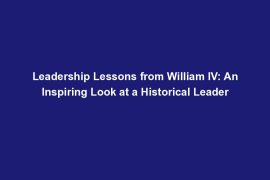Hey there, history buffs and aspiring leaders! Today, I want to take you on a journey back in time to explore the leadership style of James I of England. Now, you may be thinking, Why should I care about what some long-dead king did centuries ago? Well, let me tell you, studying historical leaders like James I can actually provide us with valuable insights for modern leadership practices.
James I was quite the character – known for his diplomatic prowess and struggles with maintaining power and authority. But what can we learn from his reign that can help us navigate the complexities of leadership today? Let’s dive in and explore some key lessons from James I that are still relevant in our contemporary world. So grab a cup of tea (or coffee) and let’s get started!
Importance of diplomacy and negotiation in leadership
One of the key leadership lessons we can learn from James I is the importance of diplomacy and negotiation in effective leadership. During his reign, James I was known for his diplomatic efforts in maintaining peace and stability both domestically and internationally. He often worked to negotiate treaties and alliances with other countries, demonstrating his skill in resolving conflicts through dialogue and compromise.
In modern leadership settings, the ability to negotiate and engage in diplomatic efforts is crucial for building strong relationships and resolving disputes. Leaders who possess strong negotiation skills are better equipped to navigate complex situations and find mutually beneficial solutions. By studying James I’s diplomatic strategies, we can gain valuable insights into how to effectively communicate, collaborate, and negotiate in our own leadership roles.
Examples of James I’s diplomatic efforts during his reign
One notable example of James I’s diplomatic efforts was his negotiation of the Treaty of London in 1604, which ended the Anglo-Spanish War and secured peace between England and Spain. By engaging in diplomatic talks and finding common ground with the Spanish, James I was able to achieve a peaceful resolution to a longstanding conflict.
Another example is James I’s diplomatic relations with the Ottoman Empire, where he sought to establish trade agreements and peaceful coexistence. These efforts not only strengthened England’s position on the world stage but also demonstrated James I’s commitment to diplomacy as a means of resolving international conflicts.
How these skills can be applied in modern leadership settings
In today’s globalized world, leaders face a myriad of challenges that require diplomatic solutions. Whether it’s negotiating business deals, resolving team conflicts, or managing international relations, the ability to engage in diplomacy and negotiation is essential for effective leadership. By studying the diplomatic efforts of historical leaders like James I, we can learn valuable lessons on how to communicate effectively, build trust, and navigate complex relationships in our own leadership roles.
Implications for Modern Leaders
So, how can we take the leadership lessons learned from James I and apply them in our contemporary world? Let’s dive in and explore the implications for modern leaders.
Application of James I’s leadership lessons in contemporary settings
One of the key takeaways from studying James I is the importance of diplomacy and negotiation in leadership. In today’s globalized world, where interactions with diverse cultures and stakeholders are the norm, these skills are more valuable than ever. Just as James I navigated delicate diplomatic relationships with other countries, modern leaders must be adept at building consensus and finding common ground with a variety of stakeholders.
Balancing power and authority is another critical lesson we can learn from James I. His struggles with Parliament demonstrate the challenges of asserting authority while respecting the views of others. Today’s leaders can benefit from understanding the nuances of power dynamics and the importance of collaboration in achieving common goals.
Reflection on the importance of adapting historical leadership practices to fit current challenges
While historical leaders like James I provide valuable insights into effective leadership practices, it’s essential for modern leaders to adapt these lessons to fit the unique challenges of our time. The world is constantly evolving, and leaders must be nimble and able to adjust their strategies to meet changing demands.
Call to action for leaders to learn from the past and continuously improve their leadership skills and techniques
In conclusion, studying historical leaders like James I can be a powerful tool for modern leaders seeking to enhance their leadership effectiveness. By learning from the successes and failures of the past, we can better understand how to navigate complex leadership challenges in our own organizations. So, let’s take inspiration from James I’s legacy and commit to continuous learning and improvement in our own leadership journey.



